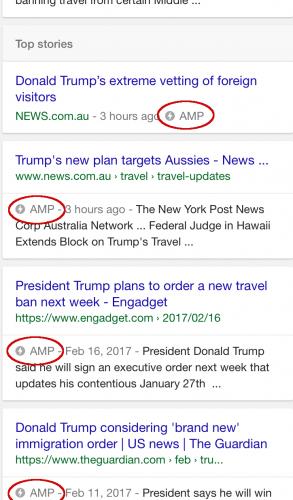In this guest post, senior business manager, Mike McGarry (pictured below), from Sydney-based programmatic marketing firm Bench, says advertisers worried their ads aren’t even being seen on mobile probably do have good reason to fret…
One thing about programmatic advertising is that unlike traditional media you often don’t get to see your own ads in action. Unlike a billboard or television commercial you are completely reliant on sophisticated targeting methodologies which by their very nature exclude you from seeing your own advertisement.
No matter how much faith you have in your technology, your targeting or your vendors there is still a tiny little voice in the back of your head which wonders if your ads are even being seen at all.
The image above is a screenshot from a large publisher’s “accelerated mobile page” or AMP for short. AMP is delivered exclusively on mobile and accessible through Google’s search results. It is a trimmed down version of the mobile web designed to load with lightning fast speed.
The problem is that although AMP content is designed to load with lightning fast speed, most advertisements are not. In fact, ads can take so much longer to load than the original page content that it leads to the situation shown in the image above, where instead of seeing your advertisement, your audience is shown a placeholder.
Wait, so just how common are Accelerated Mobile Pages?
If you pull out your phone and Google “trump’s new travel plan” you will be able to see for yourself. All results with a lightning symbol and “AMP” next to them are accelerated mobile pages. After being adopted by Google last year there are currently over 600 million published accelerated mobile pages.
Are my ads affected?
If you are using HTML5 assets that rely on feature heavy Javascript libraries such as those found in Google Web Designer and/or rich CSS styling, your ads are most certainly suffering from relatively slow load times on AMP.
What can I do about it?
As part of the AMP standard there is also AMP 4 Ads or A4A for short. This is an even more stripped down version of the AMP standard which allows your creative to load in parallel with the original content on the page.
At a DoubleClick Leadership Summit last year, Paul Muret, VP of Display, Video and Analytics at Google gave a live demonstration in which A4A creative loaded in just half a second, compared with over 3 seconds for non-A4A creative.
You can also serve A4A creative on standard non-AMP mobile web environments. However, be aware that functionality and styling will seem limited compared to what you are used to.
Taking things one step further.
Regardless of whether or not your creative is designed for AMP, if you are measuring the results of your mobile programmatic campaign based on a KPI such as “reach & frequency” you are heavily exposed to the risk of your advertisements not being viewable.
To mitigate this risk, it is imperative that your programmatic campaigns are optimised towards a goal such as sales, enquiries, registrations, engagement or at the very least viewable impressions. Have you ensured that you or your programmatic partner are utilising cost per action, cost per click or cost per completed view bidding strategies? If not, perhaps you are the one with the blindfold on…











